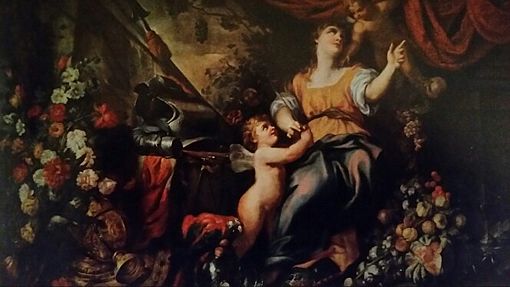Domenico Piola facts for kids
Domenico Piola (1627 – 8 April 1703) was a famous Genoese painter from the Baroque period. He was a leading artist in Genoa during the second half of the 17th century. Piola painted large ceiling frescoes for many churches and palaces in Genoa. He also created canvas paintings for private art collectors. His family studio was very busy and often worked with other artists.
Contents
Biography of Domenico Piola
Piola was an Italian painter, draughtsman, printmaker, and designer. He was the most important artist in Genoa in the late 1600s. He worked for both public buildings and private art collectors. His first teacher was his brother-in-law, Stefano Camogli, who was 17 years older than him.
Piola also learned from his older brother, Pellegro. Later, he studied under Pellegro's teacher, Giovanni Domenico Cappellino (1580–1651).
From 1650 onwards, the Piola family became very important in decorating ceilings in Genoa. This continued for almost a century. Domenico was the main artist in the family studio, known as Casa Piola. Other family members who worked there included his younger brother, his brother-in-law Stefano Camogli, his three sons, and his two sons-in-law. The studio made it easier to design and create decorated ceilings. They also made designs for sculptors and for people who worked with wood, ceramics, and metal.
In 1684 and 1685, Domenico traveled to Milan, Piacenza, Bologna, and Asti. In Piacenza, he painted decorations in the Casa Baldini. In Genoa in 1688, he and Gregorio de’ Ferrari started decorating rooms in the Palazzo Rosso. They chose the theme of the four seasons. Piola painted Autumn and Winter, while Ferrari painted the more cheerful Spring and Summer. Some of Piola's early drawings for the Winter painting still exist today.
Domenico Piola's Artworks
Piola's early copies of Giovanni Benedetto Castiglione's work helped him. His work with Valerio Castello in the late 1640s and early 1650s also helped him develop a more Baroque style.
Piola learned a lot from Castiglione's art. You can see this in his painting The Communion of Clare of Montefalco. This painting is now in the British Museum in London. You can also see Castiglione's influence in Piola's paintings in the Oratory of St John the Baptist at Spotorno.
By 1670, Piola's artistic style was fully developed. The influence of Parmese art became stronger after Gregorio de’ Ferrari returned from Parma around 1672. The style of Correggio encouraged Piola's own love for diagonal movement, bright colors, and figures that looked like they were coming out of the painting. In 1674, Ferrari married Piola's daughter. This made the work of Casa Piola much bigger. In the 1670s and 1680s, the two artists worked together on many fresco projects.
In 1684, Piola began to paint frescoes in the choir of San Leonardo. He also started decorating two rooms in the Villa Gropallo at Zerbino. All this work stopped that year because a French attack destroyed much of Genoa. Domenico's house and studio were also ruined.
Piola often worked with his brother-in-law, Stefano Camogli. Camogli was an expert in painting still life scenes and animals. For example, in the Allegory of Summer, Camogli painted the still life parts and Piola painted the people. This was also true for the Allegory of Peace and Abundance.
The Piola Family Studio
Other artists in the Piola family included Domenico's brother, Giovanni Andrea. His three sons, Paolo Gerolamo, Anton Maria, and Giovanni Battista, were also artists. His two sons-in-law, Gregorio de’ Ferrari and Domenico Parodi, were also artists. Gregorio de’ Ferrari was his most talented student and married his daughter, Margherita Piola. His brother-in-law, Stefano Camogli, was also part of the group.
The large family studio, called Casa Piola, was excellent at both quadratura fresco decoration and canvas paintings. Quadratura is a type of painting that makes flat ceilings look like they have three-dimensional architecture. Generations of artists, even into the 20th century, came from the Piola-De Ferrari family line. This included Giovanni Maria De Simoni, who died in 1913 in the original home of Domenico's family.
Where to See Piola's Art
You can find Piola's artworks in many collections around the world, including:
- Museo dell'Accademia Ligustica di Belle Arti, Genoa
- Palazzo Bianco, Genoa
- Palazzo Rosso Gallery, Genoa
- Drawings from the Biblioteca Ambrosiana, Milan
- The Royal Collection, London
- Courtauld Institute of Art, London
- J. Paul Getty Museum, Los Angeles
- Fine Arts Museums of San Francisco
- Hermitage Museum, Saint Petersburg
See also
 In Spanish: Domenico Piola para niños
In Spanish: Domenico Piola para niños


